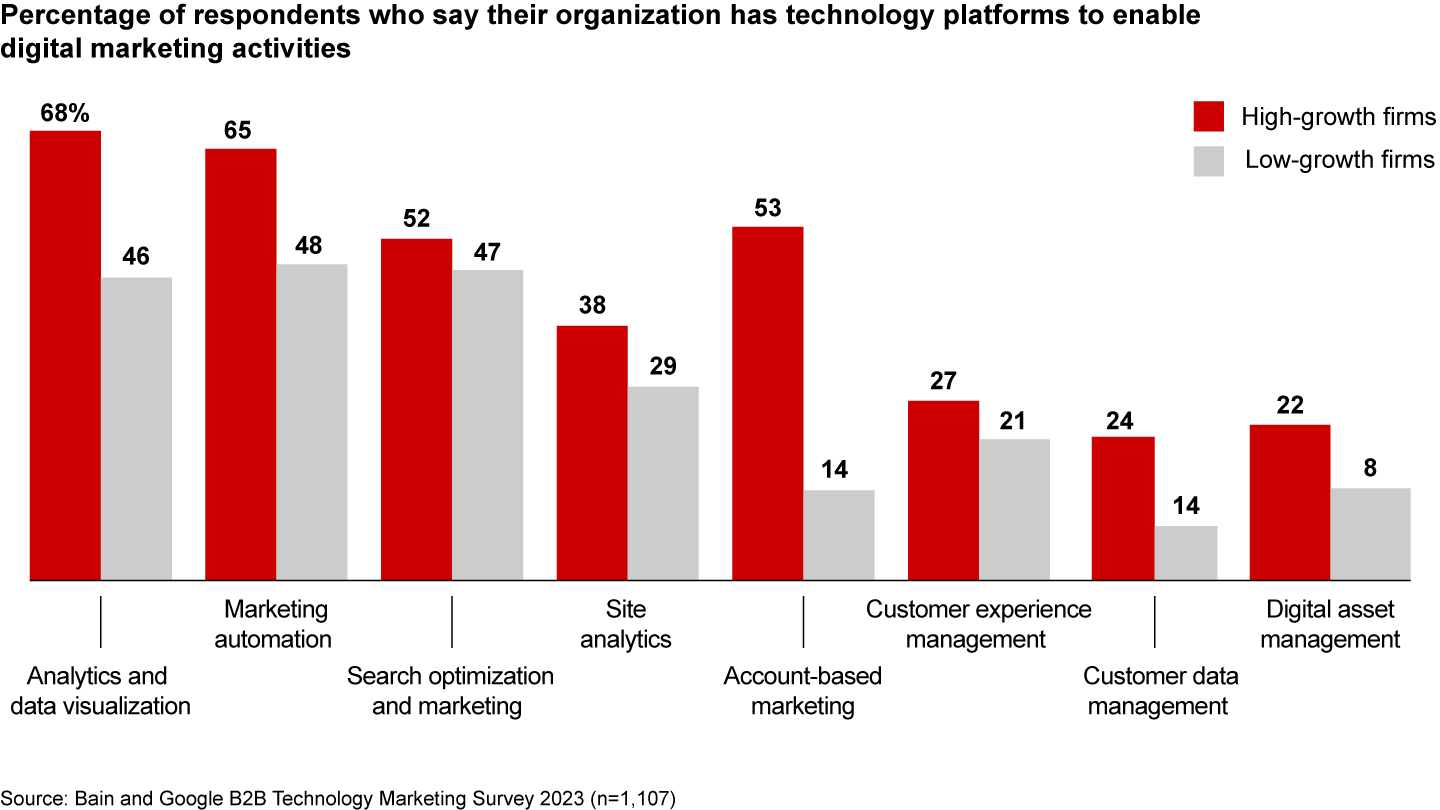Brief

At a Glance
- Business-to-business software companies can benefit from changes along three dimensions, a new survey by Bain and Google shows.
- Revenue-growth leaders devote more time and resources to experimentation around digital marketing and AI.
- High-growth firms use more marketing measurement methods and have around 30% greater confidence in those methods, on average.
- The leaders also have more in-house skills and technology around digital marketing and AI, as well as tight alignment between sales and marketing.
Many companies in business-to-business (B2B) software are struggling to consistently generate strong revenue growth. They’ve been trying to bridge the disconnect and tensions between sales and marketing groups, improve the quality of their customer data, and fulfill the promise of account-based marketing. For each of those issues, some executives have searched for an overarching solution.
It’s clear that no single solution will lead to consistent, outsize revenue growth. But there is a proven path forward, which involves making changes on three broad fronts: experimentation, measurement capabilities, and broader in-house skills.
Bain & Company’s recent survey of sales and marketing executives at about 1,100 US software and cloud hosting companies, in collaboration with Google, sheds light on the characteristics of companies that have managed to find more consistent revenue growth. And because software companies often blaze early trails in sales and marketing practices, the insights apply to firms in many other B2B industries.
Commitment to digital marketing experimentation
Revenue-leading organizations in our survey—which we define as having high revenue growth and website traffic growth over the past three to five years—devote about 50% more budget and 80% more staff hours to digital marketing experimentation compared with laggards, in part to extract more value from innovations such as artificial intelligence (AI). Other companies that treat experimentation as an afterthought, or pursue it only if they have extra budget, do not realize the same performance gains.
One company with a thoughtful approach is Oracle. It has a dedicated structure and funding to encourage experimentation, and it fields innovation teams to accelerate and scale up the experiments. The company ran an experiment with an AI-enabled virtual assistant tool that handles communications with customers and provides conversion-ready prospects to the sales group. Even at the start, with just a few employees dedicated to the project and minimal funding, the AI engine delivered substantial value, putting $140 into the sales pipeline for every $1 invested and increasing conversions fourfold. The company then expanded the team and funding to scale up the tool.
Other companies are reporting new gains from adopting AI for various use cases. On average, respondents report up to 15% improvement in key performance indicators after implementing AI use cases.
In addition, firms that are more mature in their experimentation have much greater AI adoption (see Figure 1). They realize 30% higher productivity gains vs. those with a thin track record of experimentation. Furthermore, firms that have adopted AI technologies across traditional and generative AI use cases report a 16% average improvement in their customer conversion rates.
Firms with mature experimentation capabilities have higher rates of AI adoption


Advanced measurement and attribution capabilities
High-growth firms have invested in adopting savvy measurement and attribution methods across the customer life cycle. According to our survey, they are two to three times more likely to measure signals such as account engagement and intent-based third-party data. On the back end, these companies have, on average, around 30% more confidence in their marketing measurement and attribution methods, such as multi-touch attribution, lift studies, and propensity modeling.
One global provider of a financial technology platform, for instance, implements a combination of media mix modeling (MMM), advanced attribution, and incrementality testing. The combination of methodologies allows the company to determine precisely how much to spend and the best mix to deliver revenues. Results from incrementality testing get fed back into the MMM analysis in real time, allowing the team to revise forecasts and marketing investments dynamically while improving model accuracy. Robust segmentation and propensity modeling further improve measurement; these help the team pinpoint the prospects and accounts most likely to convert (or not) based on behavioral and firmographic triggers, and to tailor marketing tactics accordingly.
An operating model that relies on in-house expertise
Revenue-leading organizations have more in-house skills and more marketing technology than their low-growth counterparts (see Figures 2 and 3). Specifically, our survey found, revenue leaders are two to six times more likely to have advanced in-house capabilities such as data science and analytics, marketing automation, and account-based marketing. On average, the leaders are five times more likely to install technology serving these areas.
High-growth firms have more in-house marketing capabilities …


… and more in-house digital marketing technology


Best-in-class organizations are also more likely to report having tight collaboration between marketing and sales through aligned revenue incentives. Some of these companies have broken through the silos separating sales and marketing groups by creating designated revenue marketing teams that oversee the end-to-end sales funnel and meet frequently with the sales group to measure the effects of marketing campaigns. The joint approach makes marketing more agile, gives a company a clearer view of the entire customer experience, and more accurately gauges the impact of marketing campaigns.
* * *
Marketing benefits from a sharper focus on revenue growth and a joined-up approach with the sales team. As B2B companies expand their experimentation, improve their measurement capabilities, and develop more in-house expertise, they raise the odds of consistent, outsize revenue growth.